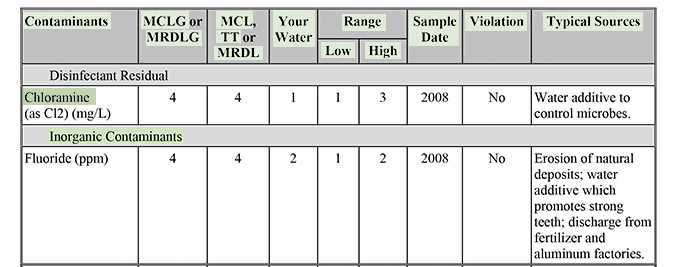Sample Consumer Confidence Report (CCR) Section 3 - Lead, Nitrate, Water Quality Data Table

Section 3 - Lead, Nitrate and Water Quality Data Table
- Additional information for Lead
An educational statement about lead is required on each CCR, even if lead is not present in your water source. -
Additional information for Nitrate
Informational statements on contaminants like nitrate may also be included in a CCR, when a system detects nitrate at levels above 5 mg/L (see table for explanations of this measure) but below the MCL Maximum Contaminant Level, or MCL (see Water Quality Data Table).Additional information for Arsenic must be included if a system detects arsenic above 0.005 mg/L and up to and including 0.010 mg/L. In many cases, this means arsenic is a natural part of the rocks in your area and over time it has leached out of the rocks and contaminated your water source.
-
Contaminants: Contaminants, as seen in this table, are not all "bad." Contaminants are anything found in your water other than hydrogen and oxygen, which make up water, and can be both healthy and unhealthy, depending on the particular substance and quantity.
MCLG: If the level of a contaminant in your drinking water is below the Maximum Contaminant Level Goal (MCLG) number indicated, then there is no known or expected risk to your health.
MRDLG: If the level of the drinking water disinfectant used by your water supplier is below the Maximum Residual Disinfection Level Goal number indicated (MRDLG), then there is no known or expected risk to your health. MRDLGs do not reflect potential benefits of disinfectants.
MCL: The highest level of a contaminant that is allowed in drinking water is the Maximum Contaminant Level (MCL). Contaminant levels above the MCL numbers indicated are a violation of EPA regulation.
TT: Treatment Technique. A required process intended to reduce the level of a contaminant in drinking water.
MRDL: The highest level of a disinfectant allowed in your drinking water is the Maximum Residual Disinfectant Level (MRDL). A certain amount of disinfectant has been shown to help control germs in the water.
Your water: Contaminants that exist in your water source.
Range detected: The "range" on your CCR refers to the levels—both high and low—at which contaminants were detected in your drinking water. A range of levels may exist due to changes in contaminant levels during a calendar year.
Sample date: The date on which a sample from your water system was collected.
Violation: A violation indicates that the level of a contaminant in your drinking water has exceeded the maximum level allowed for that contaminant by EPA. Refer to the explanation provided (in this sample titled "Violations and Exceedances: Atrazine") for more information.
Typical sources: Contaminant sources, such as runoff or erosion, are indicated here.
Contaminant name: The names of specific contaminants are indicated under each contaminant category (like chloramine under Disinfectants).
Contaminant categories: This line in the table shows what group of contaminants is being listed. This usually includes categories such as Disinfectants (like chlorine and chloramine), Inorganic Contaminants (like fluoride, nitrate, and lead), and Organic Contaminants (like atrazine and benzene), but other categories may be seen here as well depending on your water system.
Amount detected: The amount of each contaminant found in your water source will be shown here.
Click to see a large image of a sample report of these sections.
Related Pages
- Consumer Confidence Reports (CCRs)
- Sample Consumer Confidence Report (CCR) Section 1 - Introduction, Precautions and Sources
- Sample Consumer Confidence Report (CCR) Section 2 - Assessment, Contaiminants, Monitoring, Involvement
- Sample Consumer Confidence Report (CCR) Section 3 - Lead, Nitrate, Water Quality Data Table
- Sample Consumer Confidence Report (CCR) Section 4 - Action Level, Violations and Exceedances
- Page last reviewed: February 24, 2015
- Page last updated: February 24, 2015
- Content source:


 ShareCompartir
ShareCompartir
